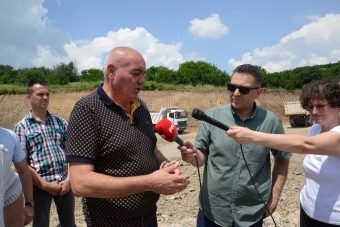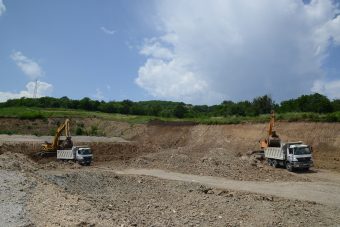
During the bygone summer, the team of Energy Portal visited the city of Pirot, the administrative centre of the district after which it got the name. Pirot district, which also includes municipalities of Babusnica, Bela Palanka and Dimitrovgrad, is mainly associated with sheep cheese, sour milk and the famous rug. However, our job has brought us to the gates of the public utility company that takes care of the most contemporary regional sanitary landfill in our country. It has been built in accordance with all standards stipulated by our law and regulations for the management of non-hazardous waste, as well as the European Union directive on the disposal of non-hazardous waste.
The landfill is managed by the Public Utility Company “Regional landfill Pirot”. The Executive Manager of this company, Nebojsa Ivanov, told us that the site where the landfill is located is old and ideal because, according to experts, it has no negative impact on the environment. It is relatively close to the city. “We are about 5.5 km away from the city centre air distance, and we are also at an adequate distance for performing this activity from other municipalities od Pirot district, which we are in charge of. Besides, it is important to emphasise that property-legal relations have been resolved, since the city of Pirot is the owner of the land on which the landfill is located, without any libilities”, says Executive Manager Ivanov, providing us with brief information on the construction of the landfill. “The infrastructure facilities, such as treatment of processed water, an administrative building and scale with accompanying elements, as well as the first landfill cell, we were constructing from 2008 to 2010, and on the first day of 2013, we received the initial amount of waste. The first phase of construction cost 5.31 million euros. The European Union provided 3.81 million euros for works and technical support, and a former Eco-Fund of Serbia participated with one million euros, while half a million euros came from the budget funds of the local self-government of the city of Pirot.
In focus:
The landfill covers the area of 19 hectares, and the second phase should include the planned rehabilitation of the first cell and the construction of the second cell. The third cell will be constructed in the third and the fourth phase. The capacity of one cell is around 30,000 tons per year, which, according to the Executive Manager Ivanov, should be sufficient for waste disposal for 10 to 12 years. The existing landfill should cover the waste disposal needs of this district in the future, that is, in the next 30 to 40 years.
During the last year and a half, they have invested a lot in the monitoring system for the possible negative impact of the regional landfill on human health and the environment. Ivanov proudly points out that they developed a isometric network last year. “The fact that you can monitor the quality of groundwater online at any time is a unique case in our country. So far, there has not been any negative impact on groundwater quality, and benchmark companies do an independent analysis on a quarterly basis, based on which a report is developed. We are obliged to submit it every three months to the Environmental Protection Agency. Of course, the purpose of this online groundwater quality monitoring system is to be able to respond quickly in case any change occurs, such as leakage, and well before any negative environmental impact is created.”
To perform the process water balance, they have reconstructed a system for the treatment of process water, which is automatically monitored. They have also received well-marked reports from accredited reference laboratories on soil, water and air quality.
With financial assistance of the Slovak government, they installed a state-of-the-art weather station which measures precipitation, evaporation and other parameters every second and the next step is adding the part for measuring the level of pollution. The citizens of Pirot will have real-time information on the quality of air and the concentration of PM 2.5 and PM 10 particles.
Incentives for Waste Separation in Households
Ivanov says that Vladan Vasic, the mayor of Pirot, has repeatedly pointed out that they should be satisfied because, compared to other cities in Serbia, only Pirot has a regional sanitary landfill. However, he believes that, although the
results are good, they are still far away from the standard set by the European Union in terms of waste management.
“So far, 100 per cent of non-hazardous municipal waste is disposed to the landfill. The directive mandates a reduction in the amount of waste that is being disposed of and the increase in selecting and recycling in the range of 20 to 50 per cent. Over the past two years, we undertook certain steps in this area, and they were fruitful. We will be one of four districts in Serbia (besides us, there are Pancevo, Uzice and Sremska Mitrovica) that will start doing the primary separation and selection of municipal waste. That means that each household will get two bins, and a separate transportation line will be introduced for wet and dry waste.”

The value of the primary separation project for Pirot District is 1.436 million euros, and the European Union provided the funds through IPA Fund, the Swedish Government and the Ministry of Environmental Protection. According to the executive manager, public procurement is now awaited. “The city of Pirot and the surrounding municipalities are ready. Although we currently do not have any containers for primary separation, I hope that the implementation of this project will start by the end of this year. We are also planning a campaign which will educate and motivate the population, but first and foremost, we need to create the conditions for the primary separation.” He stresses out that it is important to stimulate the citizens to separate as much waste as possible. They have a clear idea how to implement this. If each bin is chipped, with the data of a user, provided that the amount of waste is recorded during the load, then it will be known how much waste is being loaded and which street and building collect the most waste in the containers for primary selection. Ivanov says that this is not a big investment. In the next phase, they may introduce, once they have chipped bins and a bin reader, the reduction of the bills for the households that collect the most waste. It would introduce a levy on the amount of attached waste.
Prepared by: Tamara Zjacic
This article was published in the new issue of the Energy portal Magazine on CLIMATE CHANGE, september-november 2019.



